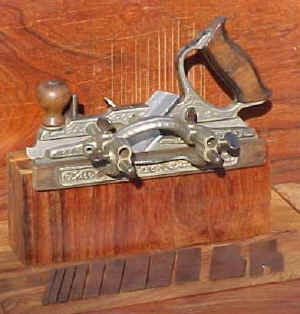
Stanley No. 46 Skew Cutter Combination Plane
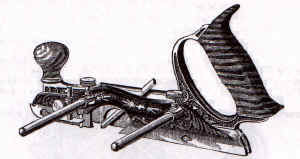
1882 Catalog Image of Stanley No. 46 Skew Cutter Combination Plane (Type 1)2
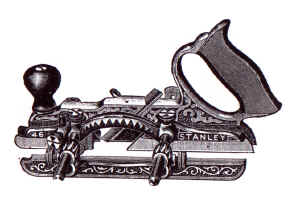
1898 Catalog Image of Stanley No. 46 Skew Cutter Combination Plane (Type 8)2
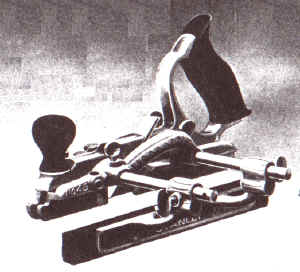
1898 Catalog Image of Stanley No. 46 Skew Cutter Combination Plane (Type 10)3
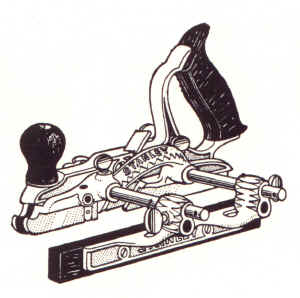
1923 Catalog Image of Stanley No. 46 Skew Cutter Combination Plane 4
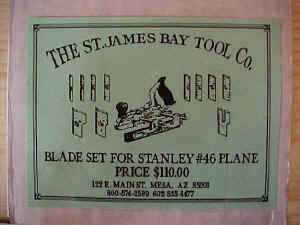
Reproduction Blade Set by St-James Bay Tool Co.
|
|
Features1: Skewed
cutter, adjustable fence and depth stop, 10 to 12 interchangeable cutters (depending on
vintage), spurs and slitter. Cutters came in a fitted wooden box.
Manufactured1: 1873 to 1942
Patents1: Dorn's 7/16/1872 (basic design)—Justus
Traut's 3/4/1873 (redesign)-F.A. Rappleye's 10/24/1882 (slitting cutter)- Bodmer's
8/23/1910 (spurs)
Dimensions1: 10-1/2 inches long
Cutters1: 11 provided: 1/4, 3/16, 5/16, 3/8, 1/2,
5/8, 13/16, 7/8, 1-1/2 inch; 1/4 inch tongue cutter; 1-1/2 inch filletster cutter.
Construction1 Cast iron, rosewood handles and fence
Finish1: Japanned from 1873 to 1892; nickel plated in
1893 and later.
User Info1: Plow, dado, filletster, and rabbet plane.
A great combination plane for dadoes due to the skewed cutter. Later models with improved
spurs and fence are more practical for use.
Average Price1: $150 to $350
Types 3-7: $250 to $500 (1876 to 1895)
Type 2: $300 to $600 (1874 to 1875)
Type 1: $1000 to $1500 (1873)
Note1: Redesigned from Dorn's basic patent,
eliminating the swing-out cutter. Quantity of cutters provided according to years of
production is as follows:
1873 to 1883................. 10 cutters
1884 to 1918................ 11 cutters
1919 and later.............. 12 cutters
On the first four types, 1873 to 1883, Stanley supplied a cast iron depth stop that fit
onto the standard depth stop stem with a screw and went over the main body. This feature
has shown up on models as late as Type 7 (1896). See Type Study for illustration. This
part is often missing and alone can sell for $50 to $150. Types 8 and later equipped with
an additional outside fence.
With regard to the standard depth stop, only one was provided. This
fit either in the provision (hole with thumb-screw) on the main body or on the auxiliary
sliding section. Enough boxed examples are known to document this point, as well as
original catalog illustrations. Many people have thought that because there are two
provisions, there should be two depth stops. This is not the case, as only one was
provided. A slitter and rear depth stop were provided for the rear of the main frame. The
No. 46 casting was used for the No. 47 plane. An add-on fence was provided for the
auxiliary sliding section from 1873 to 1895. If two holes are found in the auxiliary
sliding section, the fence is missing. This fence is also not interchangeable between
early and later types as the screws used to attach it may be different. See Type Study on
the No. 46 and Roger K. Smith's PTAMPIA, Vols. I & II.
Sources:
1. Walter, John . "Antique & Collectable Stanley Tools, Guide to
Identity and Value", 2nd Edition, 1996
2. The Stanley Catalog Collection, 1855 to 1898, The Astragal Press, Mendham, New Jersey
3. Wood, Jack P. "Early 20th Century Stanley Tools, Price Guide". Contains
reprints of the 1909 and 1926 Stanley Works Tool Catalogs.
4. Smith, Roger K., Reprint of Stanley Catalog No 120 orginally issued in 1923,
"Carpenters' and Mechanics Tools", The Stanley Rule and & Level Plant, The
Stanley Works, New Britain, Conn., U.S.A.
5. Lee, Leonard, "The Complete Guide to Sharpening", Taunton Press, Inc.,1995
6. Stanley No 46 Type 9, Tool Collection of Gordon Muster . Very Fine Condition.
Nickel is 70%. Purchased in 1998 from local dealer Stan Faullin for $95.
Purchased blade set for $110 from St-James Bay Tool Inc (had a 7 month wait for blades).
|